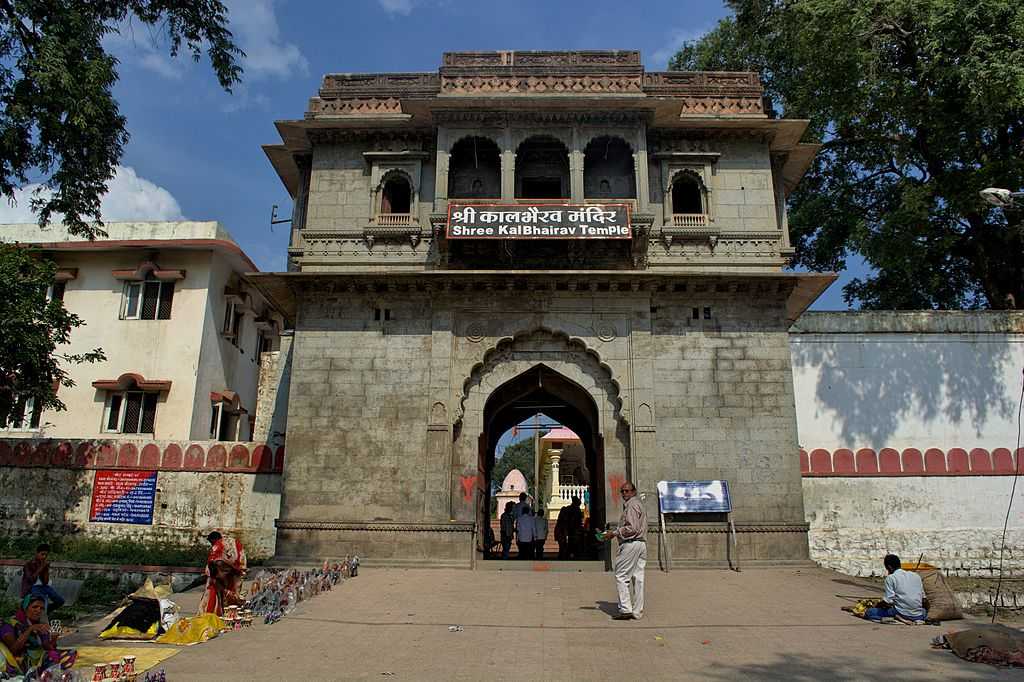Ujjain Kal Bhairava Temple, Madhya Pradesh

Address
Ujjain Kal Bhairava Temple, Goyala Buzurg, Ujjain, Madhya Pradesh 456003
Deity
Kal Bhairava
Introduction
- Location: Situated on the banks of the Shipra River in Ujjain, Madhya Pradesh, the temple is dedicated to Kal Bhairav, the guardian deity of the city. Kal Bhairav is a fierce manifestation of Lord Shiva associated with time, protection, and destruction.
- Deity: The deity’s image is represented as a rock face layered with kumkuma (vermilion), adorned with a silver head that wears a traditional Maratha-style turban (pagri). The temple is one of the busiest in Ujjain, with a continuous stream of devotees offering their prayers.
Puranic Significance
- Ancient Roots: The Kal Bhairav Temple is believed to have been originally constructed by King Bhadrasen, as mentioned in the Avanti Khanda of the Skanda Purana. Over time, the present-day structure has been rebuilt over the remains of the older temple.
- Recovered Artefacts: Artefacts belonging to the Paramara period (9th-13th century CE), including images of Shiva, Parvati, Vishnu, and Ganesha, have been found at the site.
- Historical Influence: The current structure exhibits significant Maratha influence. After the Maratha defeat in the Third Battle of Panipat (1761 CE), Mahadaji Shinde, a Maratha general, prayed to Kal Bhairav and offered his pagri (turban) to the deity. He later carried out the restoration of the temple after successfully reviving Maratha power in northern India.
- Shaivite Tradition: Kal Bhairav is a fierce manifestation of Lord Shiva, and is considered the guardian of time and the protector of Ujjain. He is worshipped by Shaivites, and the Kapalika and Aghora sects have historically regarded the temple as a significant spiritual center.
Unique Traditions and Beliefs
- Protector of the City: Kal Bhairav is considered the Senapati (Commander-in-Chief) of Ujjain, entrusted with guarding the city. The temple keys are left in his domain at night, signifying his protective role.
- Liquor Offering: One of the unique traditions at the temple is offering liquor to Kal Bhairav as part of the worship. Devotees pour the liquor into a bowl, which is believed to be consumed by the deity. This practice is rare and reflects the tantric elements associated with Kal Bhairav worship.
- Animal Symbolism: Dogs, considered the vehicle (vahana) of Kal Bhairav, are treated with reverence by feeding them as a form of offering to the deity. This is believed to bring good fortune, especially for travelers seeking protection during journeys.
- Kal Bhairav Ashtami: The most important day for worship is Kal Bhairav Ashtami, when the lord is worshipped with special rituals and offerings. Devotees prepare garlands, light lamps, and offer cashew nuts to seek the deity’s blessings for safety and protection.
Special Features
- Chief of Ashta Bhairavas: Kal Bhairav is regarded as the leader of the Ashta Bhairavas (the eight Bhairavas), a significant element in Shaivite tradition. His temple holds special importance among followers of the Kapalika and Aghora sects, both of which have a strong presence in Ujjain.
- Maratha Tradition: The pagri (turban) that adorns the head of the deity reflects a deep historical connection with the Maratha dynasty, particularly the Shinde (Scindia) family of Gwalior.
- Architectural Influence: The temple showcases Malwa-style architecture, with traces of ancient Malwa paintings still visible on the temple walls, though most have faded over time.
- Deep Stambh: The temple features a deep stambh (pillar of light), where devotees light lamps in hopes of having their wishes fulfilled.
Festivals and Celebrations
- Kal Bhairav Ashtami: This day, dedicated to Kal Bhairav, is the most significant festival for the temple. The deity is worshipped with great devotion, and offerings of liquor, cashew nuts, and lamps are made. Special rituals are performed by devotees to seek his protection and blessings, particularly for safe travels and overcoming obstacles.
Century/Period/Age
1000- Years old
Managed By
Archaeological Survey of India (ASI)
Nearest Bus Station
Ujjain
Nearest Railway Station
Ujjain Station
Nearest Airport
Indore




